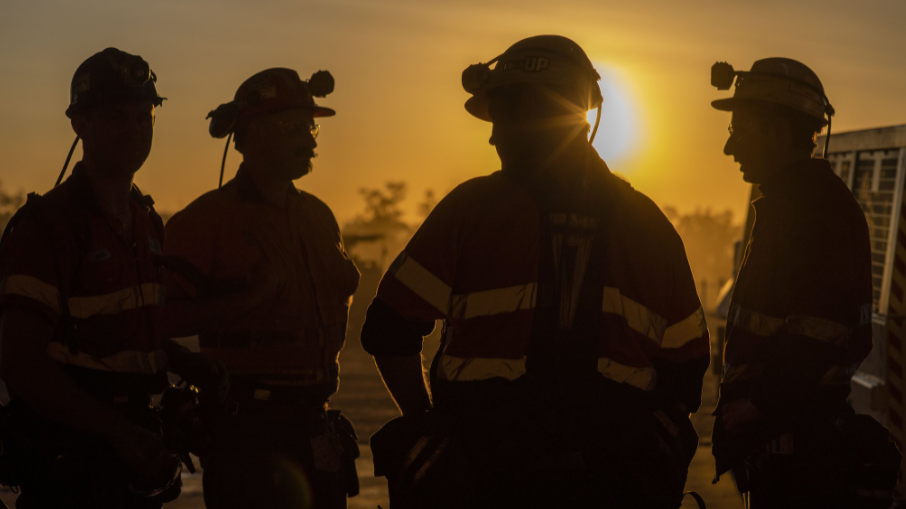Reuters | August 11, 2022 |

Workers at Grosvenor mine (Credit: Anglo American)
(The opinions expressed here are those of the author, Clyde Russell, a columnist for Reuters.)

One of the refrains of the environmental lobby is that Australia is extremely well-placed to become a renewable energy superpower, and that this will replace the loss of revenue from coal and natural gas exports.
The problem is that only one of the two above assertions is accurate, namely that Australia is in pole position when it comes to many of the minerals that will be critical to the energy transition.
These include lithium, where Australia is already the world’s top producer, as well as copper, nickel, zinc and other metals.
Even iron ore can be viewed as vital to moving the world from fossil fuels to renewables, given the essential role of steel in building out electric grids, power networks and wind turbines.
But the idea that Australia can compensate ending the export of coal and liquefied natural gas (LNG) by boosting output of energy transitions metals is somewhat fanciful.
It would take an absolutely astonishing increase in production of lithium and other renewable energy metals to come anywhere close to the current level of export revenue derived from thermal and coking coal, as well as LNG.
The Australian government’s commodity forecasts give an indication of the scale of the challenge.
The June quarter Resources and Energy Quarterly forecast that Australia’s mined lithium output would rise from 218,000 tonnes in 2020-21 fiscal year to 438,000 tonnes by the 2023-24 fiscal year.
The value of lithium exports is forecast to rise from A$1.06 billion ($750 million) in 2020-21 to A$8.71 billion by 2023-24.
A rise of more than 700% in export revenues from lithium certainly looks impressive, and the Australian government also expects the country’s share of global output to rise slightly by 2024 to around 46% from the current 41%.
But even these bullish figures show that lithium will remain well behind the export revenues for coal and LNG.
Coal, LNG dominant
Exports of metallurgical coal, used to make steel, were valued at A$58 billion in 2021-22 and the government expects they will decline to A$41 billion by 2023-24 as the global price softens.
Thermal coal exports were valued at A$39 billion in 2021-22, and are forecast to decline to A$31 billion by 2023-24.
The combined export value of both grades of coal is A$72 billion in 2023-24, and it’s worth noting that this is a conservative forecast, especially in the light of the current high price of thermal coal caused by Russia’s invasion of Ukraine disrupting global energy markets.
LNG export revenue was A$70 billion in 2021-22 and is expected to remain stable at around A$68 billion by 2023-24, according to the government forecast.
Similar to coal this LNG price estimate is on the low side, with the government predicting around $10.79 per million British thermal units (mmBtu) in 2023-24.
This is substantially below the current spot price of around $44.71 per mmBtu, and while it’s unlikely the current near-record high prices will persist for an extended period, it is possible that they will exceed the forecast, especially if Europe continues to seek to replace piped gas from Russia.
Looking at forecasts for Australia’s export revenues for other metals essential to the energy transition shows a more mixed picture.
Australia is the world’s third-biggest exporter of copper and sixth-largest producer, and export revenue is forecast to rise to A$15 billion in 2023-24 from A$12 billion in 2021-22.
Exports of nickel are forecast at A$5.8 billion in 2023-24, down from A$6.7 billion in 2021-22.
Exports of zinc, which is mainly used to galvanise steel, but also has potential as a battery metal, are forecast at A$3.8 billion in 2023-24, down from A$4.2 billion in 2021-22.
Taking lithium, copper, nickel and zinc together gives forecast export revenue of A$34 billion in 2023-24, which is less than a quarter of the A$140 billion forecast for LNG and both grades of coal.
It is likely that Australia’s production of metals for the energy transition will continue to accelerate in the years beyond the 2023-24 horizon, but for them to overtake and replace the revenue from shutting down coal and LNG exports will take enormous investment in mines, infrastructure and processing plants.
Australia can become the renewable energy superpower many environmentalists and miners dream of, but a dose of realism on the scale and cost of achieving the goals would be welcome.
(Editing by Kim Coghill)
No comments:
Post a Comment